Research
Monthly Archive: December Rese
In Hot Water – the Ongoing Debate on Bottled Water Extraction in Ontario

In the quiet countryside of the county of Wellington, echoes from a clash between the local community and mega-corporation Nestlé still linger in the air. Starting in 2015, the debate over Nestlé’s water extraction in Aberfoyle and Elora sparked outcry from community members and organizations that got the attention of the province (and indeed the international community). It is time to take a look at what has happened since, and what both Nestlé and anti-water bottling organizations have to say about it, for the battle is far from over.
When Things Go Wrong for Right Whales
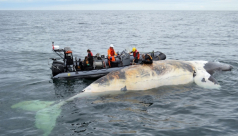
Guest blog written by Environmental Visual Communication student Viridiana Jimenez
The death of seventeen right whales in 2017 represents a loss of over 3% of the population. The significance of this loss has sent the scientific community into a panic. Their deaths were primarily caused by ship collisions or entanglements with fishing gear. As frequent visitors to the Gulf of St. Lawrence, we must now work together to save this species from extinction.
Trees for Life in Lakefield
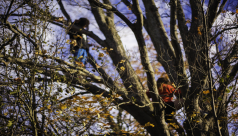
Guest blog written by Environmental Visual Communication student Fenella Hood
When Rebecca Rose left her home in Leslieville and moved her three young children to the quaint village of Lakefield, she felt secure in the belief that she was improving their lot in life. Then one day a notice was slipped through her door from the Township of Selwyn announcing her next-door neighbour's severance application to build a second house and increase his selling power. His small corner lot boasts a stand of seven mature trees that will need to be cut down to make room for the build. “It felt like being kicked in the stomach. I don't want those trees to die, and I don't want to tell my kids.”
From Poop to Plankton: Working Together to Conserve our Ocean’s Gardeners
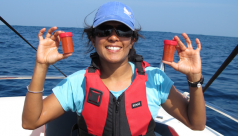
Guest blog written by Environmental Visual Communication student Meghan Callon
From the ROM’s recent “Out of the Depths” Blue Whale Exhibition to the upcoming Canada’s Oceans: Towards 2020 Symposium, the ROM has had a big focus on our oceans this year. In fact, there have been many eyes on Canada’s oceans recently. The Society for Marine Mammalogy Conference was held in Halifax, NS, just two weeks ago, bringing together some of the greatest ocean thinkers from around the world. There, Dr. Asha de Vos gave a keynote speech describing her journey to understanding how blue whales act as our ocean’s gardeners. Check out this blog to learn more about the incredible story of blue whale poop and the researcher who studies it!
True Blue Detectives
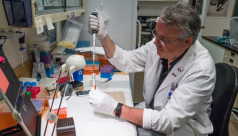
Guest blog written by 2017 Environmental Visual Communication student Connor McDowell
The Royal Ontario Museum has marked yet another first for science with the Blue Whale Project. This achievement could hold keys to the conservation of this majestic, endangered mammal – not to mention a deeper understanding of the unique evolutionary history of the largest living animal on Earth. The beginning of this story starts two thousand kilometers away, on the shores of Newfoundland, Canada with something so small that you can't see it with the naked eye.
Singing the Blues: The Mystery of B105
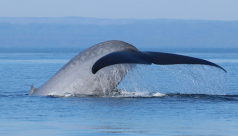
Guest blog written by 2017 Environmental Visual Communication student Viridiana Jimenez
The ocean’s largest and most iconic animal, the blue whale, can produce sounds that cross entire oceans and can be heard from one end of the planet to the other. With humans’ increased presence in the oceans, how are these charismatic giants affected by—and adapting to—our noisy activities? In this blog we follow the story of a single whale, B105 “Invasor”, and muse on how it may have changed its ways to contend with our cacophony.
Sebastian Kvist: Leech Hunter

Guest blog by Environmental Visual Communication student Sally McIntyre
When most people think about the Royal Ontario Museum (ROM), they think of dinosaurs or mummies. However, it is the invertebrates that live on the ocean floor and crawl through the soil that make up the most diverse collection at the ROM. So who holds the daunting position of keeper of this vast museum collection? Meet Dr. Sebastian Kvist: Leech Hunter.
The LMS Lab
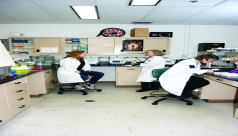
From discovering new species to preserving endangered ones, the ROM’s LMS uses genetic sequencing to study specimens.
The TRCA Calls Upon Batman for Help
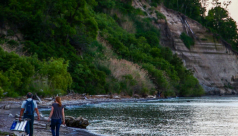
It’s been a hot summer, the sun is shining and the Scarborough Bluffs are standing tall above the Lake Ontario shoreline. But they might not be for long. The Scarborough Bluffs in Toronto’s east end are eroding at a rapid rate, increasing the likelihood of slope failure and damage to local species’ habitats. Although the cliffs have been eroding since the 1940s, the view from atop the Bluffs was too enticing to prevent people from further settling there. As houses were feverishly built along the Bluffs, the rate of erosion further accelerated.
Go with the Flow: Technology & Early Glass
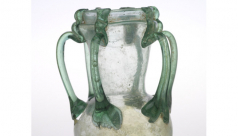
Glass is probably the most fluid of solids. Looking at blown glass, such as that in the ROM's Chihuly exhibition, is like watching movement made still. If you look carefully at the handles of the perfectly preserved handles of this Roman glass vase from Syria (above), it looks as though it is still a fluid, still dynamically moving along its flow. In a way, that is because it is. Glass essentially has the atomic structure of a fluid, but it has been so rapidly cooled that it is essentially stuck in that condition.
